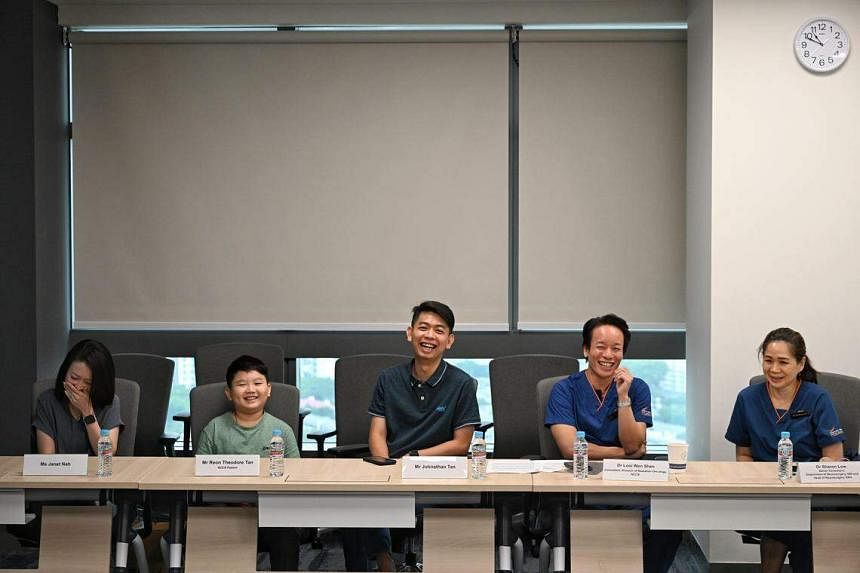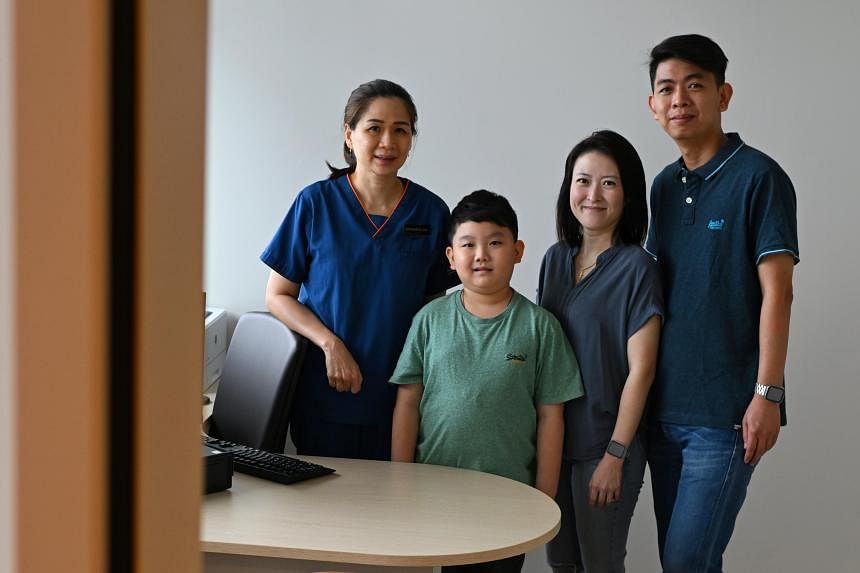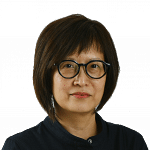SINGAPORE – When Reon Theodore Tan was in Primary 2, his mum bought him a small red pail, lined it with a plastic bag and hooked it onto his backpack. He carried the pail to school every day for many months.
“When I want to vomit, I just turn my head and vomit into the pail,” said Reon, who is nine and now in Primary 4.
The urges were immediate and he would throw up almost daily in school then. The frequency of the occurrences eventually decreased, but not enough to drop the need to take a plastic bag to school.
He subsequently developed headaches and his eyesight deteriorated.
Doctors did not find anything amiss. His mum Janet Nah suspected it was due to stress, as he aspired to do well in school, but when his legs gave way and he became dizzy earlier in 2023, they took him to a polyclinic.
Reon was referred to KK Women’s and Children’s Hospital (KKH) where he was diagnosed with benign brain tumour craniopharyngioma.
The tumour was very large, pressing on vital parts of his brain, including the optic nerves, hormone centre and brainstem. He had to undergo surgery, followed by radiotherapy to treat the remaining tumour that cannot be removed without damaging vital brain tissue, and the surfaces that were in contact with the tumour.
That was when his parents opted for proton therapy, an advanced type of radiation treatment that can precisely target tumours, reducing damage to nearby healthy tissues and organs.
It became available at the National Cancer Centre Singapore (NCCS) in June, when the Goh Cheng Liang Proton Therapy Centre started operations.
The facility, which takes up basements two to four, is one of three proton beam facilities here. It has four treatment gantries and is supported by a $50 million gift from the Goh Foundation. The other two operators, Mount Elizabeth Novena Hospital and the Singapore Institute of Advanced Medicine Holdings, also began operations recently.
Before these facilities were set up, patients here had to go overseas for such treatment. Reon is the first child patient to complete this proton therapy at the Goh Cheng Liang Proton Therapy Centre.
At a media briefing on Tuesday, Dr Michael Wang, a senior consultant and chairman of NCCS’ division of radiation oncology, said the proton beam is delivered in very small spots, layer by layer, to treat complex-shaped tumours. This helps to reduce the radiation to nearby tissues and leads to fewer treatment-related side effects.
While conventional photon radiation therapy remains the standard treatment for most solid cancers, proton therapy can benefit patients with deep-seated tumours in vulnerable areas such as in the brain or within the pelvis or abdomen, and young patients whose tissues and organs are still growing, he added.
As it is not considered a standard option, it is not eligible for government subsidies. It is, however, eligible for MediShield Life and MediSave claims, subject to the same existing limits of conventional radiotherapy treatment, he said.
Integrated Shield Plans also offer varying coverage.
Reon’s father Johnathan Xavier Tan, an aircraft engineer, said he was given an initial cost estimate of $50,000 to $55,000, with the proton therapy costing about $40,000 in the end. It was a relief, as Reon’s Integrated Shield Plan has a limit of $50,000 per policy year for this therapy, he added.
The choice, though a little unnerving at first, as it was a new therapy here, won over him and his wife, a freelance property agent.
“We don’t want him to lose his hearing, we want to give him a better quality of life,” he said of his second son. Reon has two brothers and a younger sister.
Dr Sharon Low, a senior consultant at the National Neuroscience Institute and KKH’s head of neurosurgery who operated on Reon, said the tumour was unusually large and had also pressed on the brainstem, which is very near the inner ear.
With proton therapy, the developing brain is exposed to less radiation compared with conventional therapy. There is less potential for hearing loss as well as neurocognitive deficits in the future, and also less risk of a second cancer, said Reon’s radiation oncologist at NCCS, Dr Looi Wen Shen.
NCCS’ proton beam facility has so far treated 26 patients, ranging in age from two to 83. Nearly a third of them have brain tumours, some have prostate cancers while others have head and neck cancers, including nasopharyngeal cancer.
Apart from these cancers, the other cancers approved by the Ministry of Health for proton therapy include digestive tract cancers, bone and soft tissue cancers, lymphoma, certain childhood cancers and locally advanced cancers treated with concurrent chemoradiation therapy.
Patients undergoing proton therapy go through about 30 sessions on average, with each lasting about 30 minutes, during which they have to lie completely still.

Reon would listen to his father’s favourite Chinese songs during the daily treatment, though he said at the media briefing that they were not the tunes that he likes.
“I only thought, I want to go back to (school). I also want to become a doctor next time, so I better get this done and over with.”
His 30 sessions from late July to mid-September saw him experiencing minor side effects like dizziness and slight, temporary hair loss. He has since returned to school – which he cherishes a lot more after his illness affected his attendance.
“I found out that studying is much better than staying in the hospital,” he said.


